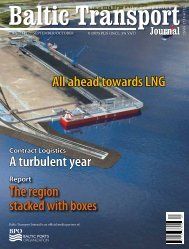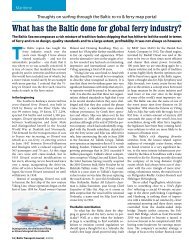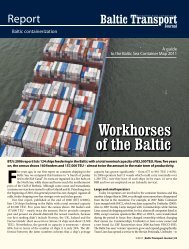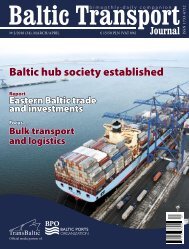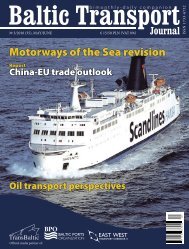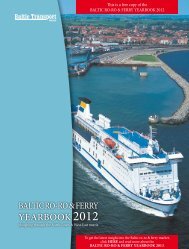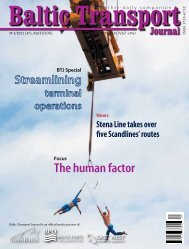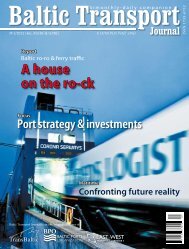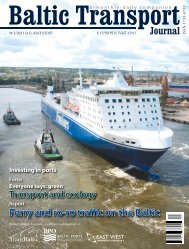BTJ 5/2011 - Baltic Press
BTJ 5/2011 - Baltic Press
BTJ 5/2011 - Baltic Press
- No tags were found...
Create successful ePaper yourself
Turn your PDF publications into a flip-book with our unique Google optimized e-Paper software.
FocusCondition-based maintenance for freight wagonsFinding optimumPhoto: DB SchenkerPhoto: DB SchenkerIn order to improve availability and reliability of freight wagons it is necessary to implement conditionbasedmaintenance. The CargoCBM research group is developing a system to make this a reality.As the exchange of goods withinthe European Union is increasingand worldwide trade is intensifying,a significant growth in goodstraffic can be expected in the next few years.The most recent appraisals estimate that thetraffic in goods transportation (tonnes transportedmultiplied by distance, in tonne/km)will increase in Germany by 69% from 2005to 2030 and by 110% by 2050. Transit trafficis expected to increase by 136% by 2030 andby 214% by 2050. However, the proportionregarding rail and barge is not supposedto be substantially higher and still only accountsfor 27%, while 70% belongs to traffictransportation. These trends are unlikelyto change without improvements made ingeneral conditions.To match climate targets, the Germangovernment is willing to take action to increasethe amount of goods transported byrail in order to reduce CO 2emissions andtake pressure off the crowded motorways.Modern and available rolling stock can beseen to be one of the main restraints to a disproportionatelyhigh growth in rail traffic.An improved efficiency in maintenance canbe the key to enhance this situation.Maintenance strategiesThere are three categories of general maintenancestrategies: permanent maintenance,preventive and reactive.When a wagon is constructed fatigueresistant(permanent) it is not supposed to50 | <strong>Baltic</strong> Transport Journal | 5/<strong>2011</strong>need any maintenance during its whole lifespan. This commonly used procedure in theautomotive industry is connected with higherproduction costs and wagon weight. Reactivemaintenance is a procedure that only dealswith the equipment after a component failure.This strategy is difficult to plan and impliesgreat storage capacities for spare components.Furthermore, consecutive faultsmay occur, which lead to further damagesresulting in additional costs and downtime.However, the fact that parts are being optimallyused can be seen as an advantage.Preventive maintenance can be separatedinto time-based and condition-basedmaintenance. The first strategy is currentlyused for freight wagons and is carried out infixed intervals in order to avoid unexpectedbreakdowns, minimize storage of spare partsand easier scheduling of down times. On theother hand, when applying condition-basedmaintenance, parts are replaced dependingon their actual wear status. To find theoptimal timing, the wear status has to beexamined regularly or permanently. The resultslie in greater reliability and availability,by simultaneously reducing costs.Today freight cars are being scheduled formaintenance in fixed intervals of six to eightyears in a preventive maintenance scheme. Askilometric performances greatly vary, freightcars are in a very different state when theycome into the workshop. Some wagons arein a really good state and could easily remainin operation without being repaired. Othersmight have shown technical problems alreadyand would have to be taken into maintenancebefore their planned time. A further difficultyis that damages through wheel flats, forexample, are occurring irregularly and thusare mileage independent. Discussions withwagon holders have shown that with the currentlyused maintenance strategy, annuallythree to four unplanned workshop visits perfreight car are occurring. This leads to problemsconcerning availability and thus cost,which have led to competitive disadvantagesof the rail freight transport in Germany.



